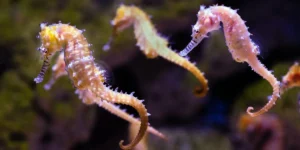
Dried seahorses are among the most intriguing and controversial items in the global trade of marine wildlife. Revered for their supposed medicinal properties, ornamental value, and cultural significance, seahorses have been harvested and traded for centuries. However, this trade raises significant ethical and environmental concerns. This article delves into the uses, trade dynamics, cultural importance, and conservation challenges associated with dried seahorses, aiming to provide a comprehensive understanding of this complex issue.
The Biology and Ecology of Seahorses
Seahorses belong to the family Syngnathidae, which includes pipefish and seadragons. They are unique for their equine appearance, with long snouts, prehensile tails, and an upright swimming posture. There are about 46 species of seahorses, found in shallow tropical and temperate waters around the world. They inhabit seagrass beds, mangroves, coral reefs, and estuaries, where they play crucial roles in the ecosystem.
One of the most fascinating aspects of seahorses is their reproductive biology. Unlike most animals, it is the male seahorse that becomes pregnant. Females deposit their eggs into the male’s brood pouch, where he fertilizes and carries them until they hatch. This unique reproductive strategy, along with their monogamous pair bonds, makes seahorses particularly vulnerable to overfishing and habitat destruction.
Traditional Uses of Dried Seahorses
Dried seahorses have been used for centuries in traditional medicine, particularly in Asia. In Traditional Chinese Medicine (TCM), seahorses are believed to have various health benefits, including boosting sexual potency, treating asthma, and alleviating pain. They are often ground into powder and mixed with other herbs or taken as a tonic. Seahorses are also used in traditional medicines in Indonesia, the Philippines, and parts of Latin America and Africa.
Beyond medicine, dried seahorses are valued as curios and souvenirs. Their unique appearance makes them popular in the ornamental trade, where they are displayed in homes or crafted into jewelry and other decorative items.
The Global Trade in Dried Seahorses
The trade in dried seahorses is a global industry, with millions of individuals harvested each year. Major exporters include countries in Southeast Asia, such as Indonesia, the Philippines, and Vietnam, while China is the largest importer. The trade is driven by high demand in traditional medicine markets, as well as the curiosity trade.
Despite their popularity, seahorses are vulnerable to overexploitation. Many species have experienced significant population declines due to overfishing, habitat destruction, and bycatch in shrimp trawl fisheries. In response to these threats, all seahorse species were listed under Appendix II of the Convention on International Trade in Endangered Species of Wild Fauna and Flora (CITES) in 2002. This listing requires that exports be sustainable and legal, with proper documentation and permits.
Conservation Challenges and Efforts
Conserving seahorses poses significant challenges due to their ecological and biological characteristics. They have low mobility, small home ranges, and specific habitat requirements, making them particularly susceptible to habitat loss and degradation. Additionally, their slow reproductive rates mean that populations recover slowly from exploitation.
One of the main conservation efforts for seahorses involves regulating the international trade through CITES. However, enforcement remains a challenge due to illegal and unreported trade. Many countries lack the resources and infrastructure to effectively monitor and control seahorse harvests and exports.
Marine protected areas (MPAs) are another crucial strategy for seahorse conservation. MPAs can provide safe havens for seahorses and other marine life, allowing populations to recover and thrive. Successful MPAs require community involvement and effective management to balance conservation goals with the needs of local people.
Research and monitoring are essential for understanding seahorse populations and the impacts of trade. Scientists use various methods to study seahorse biology, ecology, and trade dynamics, including field surveys, genetic analyses, and market assessments. This information is vital for developing effective conservation strategies and policies.
The Role of Aquaculture
Aquaculture has been proposed as a potential solution to reduce pressure on wild seahorse populations. Captive breeding programs can supply seahorses for traditional medicine, the aquarium trade, and research, potentially reducing the need for wild harvests. However, aquaculture faces several challenges, including high production costs, disease management, and ensuring that captive-bred seahorses meet market demands.
Despite these challenges, some aquaculture initiatives have shown promise. For example, Ocean Park Conservation Foundation Hong Kong has successfully bred several seahorse species in captivity. These efforts can provide valuable insights into seahorse biology and contribute to conservation.
Ethical and Cultural Considerations
The trade in dried seahorses raises important ethical and cultural questions. For many communities, seahorses are an integral part of traditional medicine and cultural practices. Balancing the cultural significance of seahorses with the need for conservation is a complex issue that requires sensitivity and collaboration.
Promoting sustainable and ethical use of seahorses involves engaging with traditional medicine practitioners, fishers, and consumers. Education and awareness campaigns can highlight the importance of seahorse conservation and encourage the adoption of sustainable practices. Additionally, involving local communities in conservation initiatives can foster a sense of ownership and stewardship.
Alternatives to Dried Seahorses
Finding alternatives to dried seahorses in traditional medicine is crucial for reducing demand. Research into the medicinal properties of seahorses and potential substitutes is ongoing. Some studies have suggested that other marine organisms, such as certain types of fish and invertebrates, may offer similar health benefits.
Promoting the use of these alternatives can help alleviate pressure on wild seahorse populations. However, any substitutes must be thoroughly tested to ensure their efficacy and safety. Collaboration between scientists, traditional medicine practitioners, and policymakers is essential for identifying and promoting viable alternatives.
Conclusion
Dried seahorses represent a fascinating intersection of biology, culture, and commerce. Their unique biology and cultural significance make them valuable, but also vulnerable. The global trade in dried seahorses poses significant challenges for conservation, requiring a multifaceted approach that includes regulation, research, community involvement, and ethical considerations.
By understanding the complexities of the dried seahorse trade and promoting sustainable practices, we can work towards a future where seahorses continue to thrive in their natural habitats. Conservation efforts must be adaptive and collaborative, ensuring that the needs of both seahorses and human communities are met. Through these efforts, we can hope to protect these enchanting creatures for generations to come.
